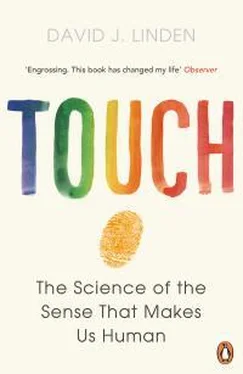2. Perhaps people living in some remote locations in Borneo or Papua New Guinea have yet to experience chili peppers or hear them described as hot, but that’s uncertain. There are some people living in the Amazon basin who have had little or no contact with the outside world, but chili peppers grow there so they may have encountered them locally.
3. Capsaicin is the main pungent compound in chili peppers, but there are also some other chemically related compounds called capsaicinoids. There are only five different species of Capsicum plants, but there are many different subspecies that have been created by humans, and these are known as cultivars. In much the same way that a poodle and a Labrador are both subspecies of the dog Canis lupus produced by human breeders, the wax pepper and the jalapeño pepper are both cultivars of the domesticated chili pepper Capsicum annuum .
4. The cold/menthol sensor, which we now call TRPM8, was first characterized by two different groups: D. D. McKemy, W. M. Neuhausser, and D. Julius, “Identification of a cold receptor reveals a general role for TRP channels in thermosensation,” Nature 416 (2002): 52–58; and A. M. Peier, A. Moqrich, A. C. Hergarden, A. J. Reeve, D. A. Anderson, G. M. Story, T. J. Early, I. Dragoni, P. McIntyre, S. Bevan, and A. Patapoutian, “A TRP channel that senses cold and menthol,” Cell 108 (2002): 705–15. And the heat/capsaicin receptor was first identified in this classic paper: M. J. Caterina, M. A. Schumacher, M. Tominaga, T. A. Roden, J. D. Levine, and D. Julius, “The capsaicin receptor: a heat-activated ion channel in the pain pathway,” Nature 389 (1997): 816–24.
5. There are also synthetic compounds that can activate TRPM8 and produce a strong cooling sensation. One of these, originally called AG-3-5 but subsequently given the more evocative name of icilin, is about two-hundred-fold more potent than menthol. E. T. Wei and D. A. Seid, “AG-3-5: a chemical producing sensations of cold,” Journal of Pharmacy and Pharmacology 35 (1983): 110–12.
6. P. Cesare and P. A. McNaughton, “A novel heat-activated current in nociceptive neurons and its sensitization by bradykinin,” Proceedings of the National Academy of Sciences of the USA 93 (1996): 15435–39. The average shower temperature for adults in the United States is 107 °F, just below the threshold for activation of TRPV1. There’s some between-individual and within-individual variation, however. For a nice review of temperature-sensitive TRP channels, see L. Vay, C. Cu, and P. A. McNaughton, “The thermo-TRP ion channel family: properties and therapeutic implications,” British Journal of Pharmacology 165 (2012): 787–801.
7. S. E. Jordt and D. Julius, “Molecular basis for species-specific sensitivity to ‘hot’ chili peppers,” Cell 108 (2002): 421–30.
8. Birds that eat chili peppers have access to a food source that is shunned by almost all other animals. Among mammals, humans are the only species that intentionally consumes chili peppers, according to this useful review article: B. Nilius and G. Appendino, “Spices: the savory and beneficial science of pungency,” Review of Physiology, Biochemistry and Pharmacology 164 (2013): 1–76.
9. The initial characterization of mice harboring a deletion of the TRPV1 gene was reported in these two papers: M. J. Caterina, A. Leffler, A. B. Malmberg, W. J. Martin, J. Trafton, K. R. Petersen-Zeitz, M. Koltzenberg, A. I. Basbaum, and D. Julius, “Impaired nociception and pain sensation in mice lacking the capsaicin receptor,” Science 288 (2000): 306–13; and J. B. Davis, J. Grey, M. J. Gunthorpe, J. P. Hatcher, P. T. Davey, P. Overend, M. H. Harries, J. Latcham, C. Clapham, K. Atkinson, S. A. Hughes, K. Rance, E. Grau, A. J. Harper, P. L. Pugh, D. C. Rogers, S. Bingham, A. Randall, and S. A. Sheardown, “Vanilloid receptor-1 is essential for inflammatory thermal hyperalgesia,” Nature 405 (2000): 183–87. Since then, the basic finding, that TRPV1 deletion abolishes capsaicin responses but only reduces heat responses and inflammation boosting of heat responses, has been replicated using specific drugs to block or desensitize TRPV1 and extended by recording the electrical signals from single sensory nerve fibers that innervate the skin.
10. S. M. Huang, X. Li, L. Yu, J. Wang, and M. J. Caterina, “TRPV3 and TRPV4 ion channels are not major contributors to mouse heat sensation,” Molecular Pain 7 (2011): 37–47; and U. Park, N. Vastani, Y. Guan, S. N. Raja, M. Koltzenberg, and M. J. Caterina, “TRP vanilloid 2 knock-out mice are susceptible to perinatal lethality but display normal thermal and mechanical nociception,” Journal of Neuroscience 31 (2011): 11425–36. Even when TRPV1 was inhibited, no further effects of TRPV2 or TRPV4+TRPV3 deletion could be seen.
11. D. M. Bautista, J. Siemens, J. M. Glazer, P. R. Tsuruda, A. I. Basbaum, C. L. Stucky, S.-E. Jordt, and D. Julius, “The menthol receptor TRPM8 is the principal detector of environmental cold,” Nature 448 (2007): 204–9; R. W. Colburn, M. L. Lubin, D. J. Stone Jr., Y. Wang, D. Lawrence, M. R. D’Andrea, M. R. Brandt, Y. Liu, C. M. Flores, and N. Qin, “Attenuated cold sensitivity in TRPM8 null mice,” Neuron 54 (2007): 379–86; and A. Dhaka, A. N. Murray, J. Mathur, T. J. Early, M. J. Petrus, and A. Patapoutian, “TRPM8 is required for cold sensation in mice,” Neuron 54 (2007): 371–78.
12. The present state of the scientific literature on the topic of TRPM8-independent sensors of cold is a bit of a mess. Some groups have claimed a role for the wasabi sensor gene TRPA1 (to be discussed soon), but others have failed to replicate these findings. To get a sense of the current state of the struggle, see D. McKemy, “The molecular and cellular basis of cold sensation,” ACS Chemical Neuroscience 4 (2013): 238–47.
13. TRPA1 was originally called ANKTM1 before the nomenclature for TRP channels was standardized. S. E. Jordt, D. M. Bautista, H. H. Chuang, D. D. McKemy, P. M. Zygmunt, E. D. Högestätt, I. D. Meng, and D. Julius, “Mustard oils and cannabinoids excite sensory nerve fibers through the TRP channel ANKTM1,” Nature 427 (2004): 260–65; and M. Bandell, G. M. Story, S. W. Hwang, V. Viswanath, S. R. Eid, M. J. Petrus, T. J. Early, and A. Patapoutian, “Noxious cold ion channel TRPA1 is activated by pungent compounds and bradykinin,” Neuron 41 (2004): 849–57.
14. The chemicals allicin and DADS from garlic/onions are chemically similar to AITC from the mustard/horseradish/wasabi family of plants. D. M. Bautista, P. Mohaved, A. Hinman, H. E. Axelsson, O. Sterner, E. D. Högestätt, D. Julius, S.-E. Jordt, and P. M. Zygmunt, “Pungent products from garlic activate the sensory ion channel TRPA1,” Proceedings of the National Academy of Sciences of the USA 102 (2005): 12248–52.
15. Cooking onions not only degrades the TRPA1 activators allicin and DADS but also breaks down fructose polymers (fructans) into fructose monomers, yielding a sweet taste.
16. The best extra-virgin olive oils produce a localized pungency that’s restricted to the throat. In fact, among experts, the best olive oils are called “two-cough” oils, as this particular effect is sought after. The compound in olive oil that produces this effect is a TRPA1-activaor called oleocanthol. TRPA1 is expressed in cells that line the pharynx, but not those of the mouth or tongue, and this distribution is suggested to give rise to the coughing effect of oleocanthol. C. Payrot de Gachons, K. Uchida, B. Bryant, A. Shima, J. B. Sperry, L. Dankulich-Nagrudny, M. Tominaga, A. B. Smith III, G. K. Beauchamp, and P. A. S. Bresline, “Unusual pungency from extra-virgin olive oil is attributable to restricted spatial expression of the receptor of oleocanthol,” Journal of Neuroscience 31 (2011): 999–1099.
Читать дальше












